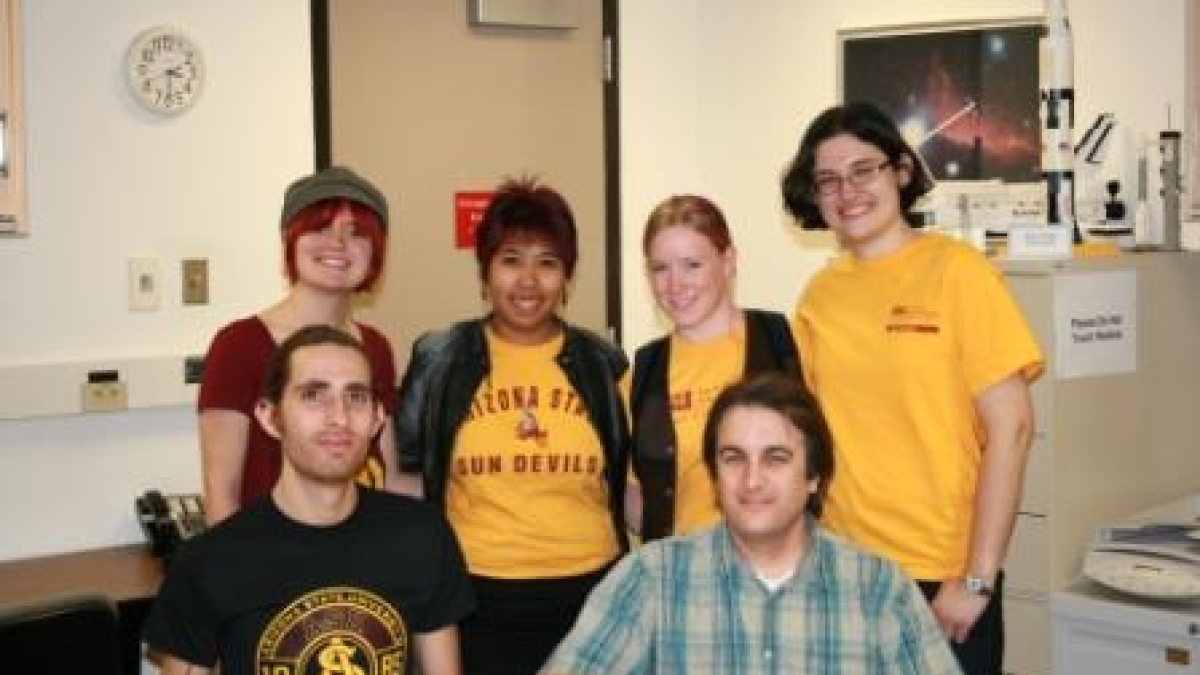Weightless Wonder: ASU students selected to fly in zero gravity plane

Made up of ASU undergraduate students, the Dust Devils Microgravity Team has been selected to fly in NASA’s 2012 Reduced Gravity Education Flight Program.
The team is one of 14 teams from across the nation selected for the highly competitive program. The students will fly in June on the Weightless Wonder, an airplane run by NASA that provides zero gravity.
The NASA program provides a unique academic experience for undergraduates to successfully propose, design, fabricate, fly and assess a reduced gravity experiment of their choice over the course of six months. The experience includes scientific research, hands-on experimental design, test operations, and educational and public outreach activities.
The Dust Devils Microgravity Team is composed of five student flyers and two faculty advisers from ASU’s School of Earth and Space Exploration (SESE) and the Ira A. Fulton Schools of Engineering. The team is headed by Pye Pye Zaw (SESE) and includes Jacob Higgins (SESE), Dani Hoots (SESE, history, anthropology), Emily McBryan (aerospace engineering, astronautics) and Amy Kaczmarowski (SESE and aerospace engineering).
The Dust Devils propose to utilize the Reduced Gravity Education Flight Program to observe the coagulation of dust particles in microgravity environments, as a function of factors such as size and composition.
Steve Desch, associate professor, advised the students on how to conduct the science experiment – providing them background literature and the implications for understanding solar system formation (coagulation is how planets start). Chris Groppi, assistant professor, advised them on the design of the instrument, the format of the proposal, and the preparation of a project budget, among other things.
“We are looking at the electrostatic properties of different variations of dust particles to better understand what causes the attraction that allows for these sets of particles to coagulate in the absence of gravity,” said Zaw. “Understanding this is important because it answers some questions about the interstellar medium, and in addition NASA is interested because this relationship may be harmful or beneficial to rover missions to places such as Mars where there are dust devils displaying some similar effects.”
Microgravity is absolutely necessary to study this because gravity will overwhelm the weaker forces in dust coagulation.
In addition, this experiment will include a simulation of a protoplanetary disk environment by testing coagulation of meteorite powders. The powders are being donated by the Center for Meteorite Studies at ASU, courtesy of its director, Meenakshi Wadhwa, also a professor in the School of Earth and Space Exploration. Better understanding of the coagulation mechanism of small particles in zero gravity will provide insight into the formation of planets from proto-planetary disks as well as the charging effects of particles on planetary surfaces.
The team will use the next six months to collect funds, build the experiment test structure, and prepare the experiment for flight week.
“We have a lot of outreach, fundraising and experiment safety preps to do between now and June, in addition to physically building our experiments,” Zaw said.
Although the cost of the microgravity flight is covered by NASA, the students will have to raise money to pay for their trip, hotel and supplies.
“We’ve raised about 54 percent of the $13,000 we need,” Zaw added.
The ASU/NASA Space Grant has supported the Reduced Gravity Flight Program in years past and will be supporting more than 50 percent of the cost for the Dust Devils Microgravity Team for this year’s competition. Three of the team members – Zaw, McBryan and Kaczmarowski – are current and past Space Grant interns.
The Dust Devils also will be participating in various outreach events throughout the state to promote interest in science, technology, engineering and math (STEM) for the program. In addition to hands-on outreach activities, the team has created a website that includes a resource page for educators with “How To’s” on performing simple gravity simulations, models and experiments in their classrooms.
In June, the students will report to Johnson Space Center (JSC) in Houston to test their hypothesis aboard NASA’s Weightless Wonder – a modified McDonnell Douglas DC-9 jetliner that takes 45-degree nosedives to simulate zero gravity. The reduced gravity aircraft generally flies 30 parabolic maneuvers over the Gulf of Mexico. This parabolic pattern provides about 30 seconds of hypergravity (about 1.8-2g’s) as the plane climbs to the top of the parabola. Once the plane starts to “nose over” the top of the parabola to descend toward Earth, the plane experiences about 18 seconds of microgravity (0g).
The students will spend nine days on-site at JSC learning about NASA, undergoing physical training and performing their experiments aboard the Weightless Wonder. The program tries to put students through the same procedures as those followed by full-time professional research scientists.
“This was a motivated, hard-working group of students,” said Desch. “We are very proud of this success.”
The ASU team was among 14 teams selected from 60 that applied. Other teams selected include those from the Massachusetts Institute of Technology and Yale University.
The Dust Devils Microgravity Team is the fifth such team ever selected from ASU. Other ASU teams participated in the Reduced Gravity Education Flight Program in 1999, 2001, 2002 and 2003 and were supported by the ASU/NASA Space Grant Program.